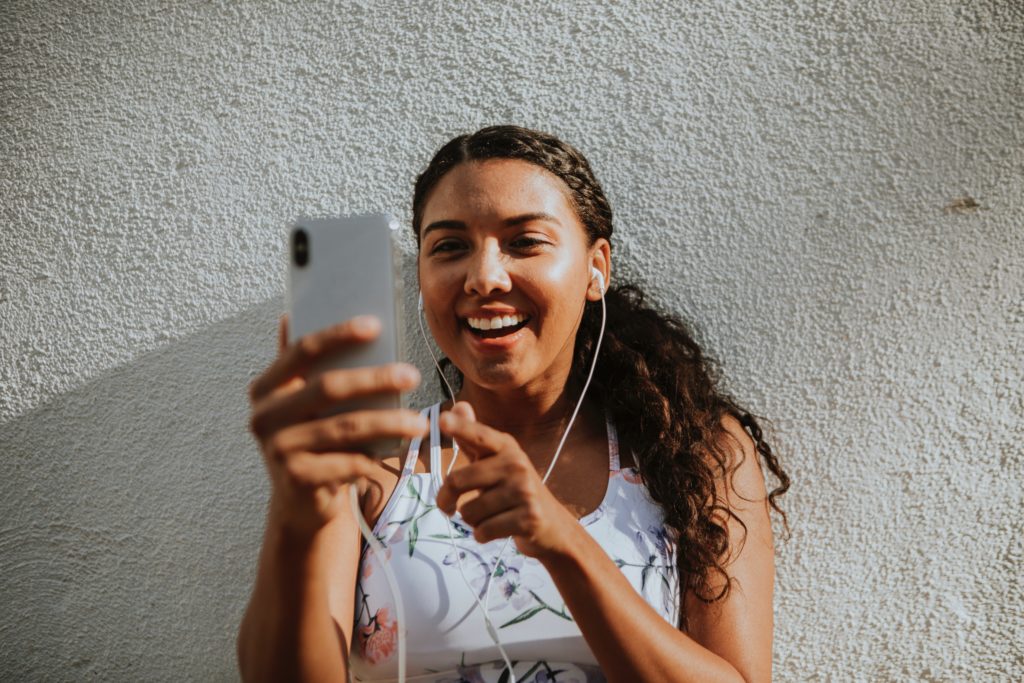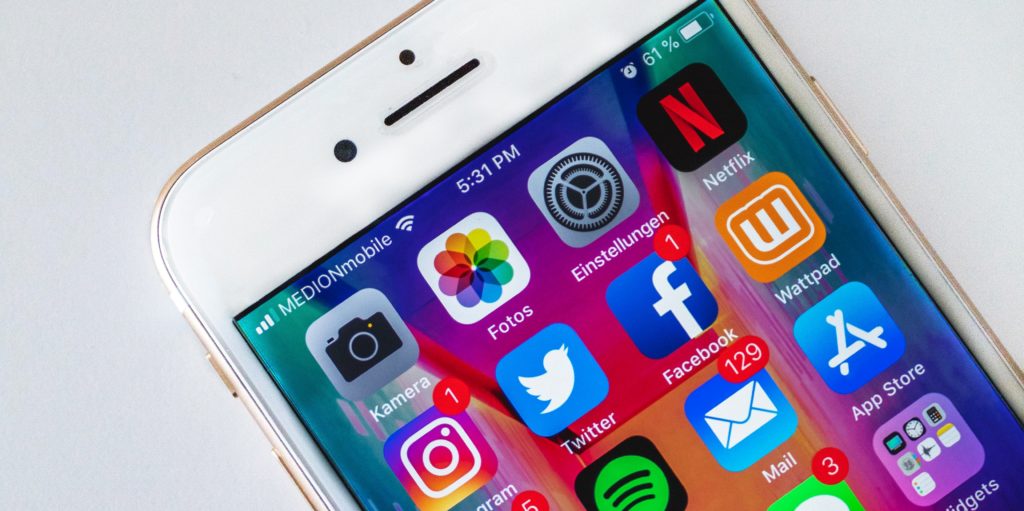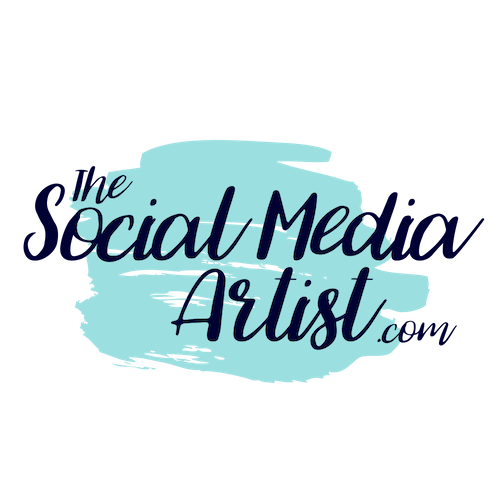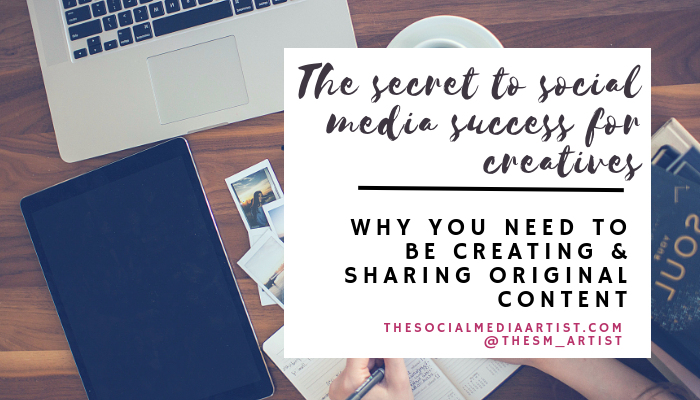
Artist Marketing, Branding, Facebook, Instagram, Pinterest, Snapchat, Social Media, Soundcloud, Twitter, Youtube |
No matter what type of art you create or are involved in, when it comes to building an audience that really appreciates your work, having a presence online will no doubt help you reach that goal. But with so many different ways to connect with your audience, which is the best? And how can you build an audience that really loves what you do? Here’s where original content comes in.
In this article we are going to explain exactly what original content is, what it means for you, and how you can start to create content that works for both you and your audience. Let’s go!
So, what exactly is “original content”?
Social media marketing expert Kimberley-Ann Jiminez describes original content as:
“Any piece of content created by your brand used to instruct, educate, entertain or empower”.
That means basically anything that you create from scratch, whether it be a blog post, an infographic, a photo, or a video; all of these are original content.
Why do I need to create “original content” when I’m an actor/ singer/ artist/ other?”
When it comes to your online presence, there are so many reasons why it’s important to always be creating and sharing fresh, new content with your audience (and a variety of types, if you can!). Let’s outline the main reasons:
1 – Helps you stand out in a crowded online space
Even though there may be thousands of people all working in the same niche; it’s your individual story and experience that can really create and provide value to your audience. A good way to stand out is to truly show your personality and what you have to bring to the table.
Even in an industry where there are “industry standards” for work or for content creation, adding your personal flavour to the conversation can really make you stand out.
2 – Become a subject matter expert
When you give your audience more information about your topic you are establishing yourself as someone who really knows what they’re talking about. Your confidence in your knowledge shines through, which in turn makes people trust you. When people trust your opinion and advice (and it works for them) they will come back time and time again to seek out more information. For a lot of people starting out in your industry or niche, they want and need all the help they can get. That’s where you can provide real value to them, in turn building an engaged audience!
3 – Build your community
Original content that your audience enjoys and can utilise helps forge relationships – they trust you and they want to know more about what you have to offer. Similarly, even if your content is something that entertains or inspires your audience, it’s still eliciting a response from your audience, and that’s what helps build your audience. Similar to how your art can make the audience feel or think in a different way, your posts should do the same.
The more your audience love your content the more comments, likes, shares and mentions you’ll get. Not only that but people will trust you and feel like they know you, which in turn will make them comfortable approaching you and initiating conversation via social media. Interacting with your audience will make potential fans think you really care about the people you’re interacting with, which in turn will make them want to join the club. The more engaged your audience is, the more you’ll attract more!
4 – Add value to your audience
When creating original content, whether you entertain, inform or educate, you’re offering your audience something of value. It could be knowledge that helps them in their industry, information that helps them progress in their niche, or just something to entertain them when they have some free time. Whatever role your content has for your audience, it’s important to maximise it so they keep coming back.
5 – Builds rapport with your audience which potentially leads to sales
Although we’ve already covered building a community (see #3), it’s important to note that building an engaged community can also lead to potential sales. If you’re a creator who is selling your products or work online, a thriving community will be more likely to buy.
It can be particularly hard for independent artists to make sales online, but if you have a community that like and trust you, they will want to support you, and in turn feel much better about parting with their money for you.
So how do I choose what type of content to create?!
The easiest thing to do is to look at what others in your niche are creating and pay attention to the pieces that have had a lot of likes, comments and shares. If it works for your competitors, it’s probably going to work for you.
However, this isn’t a fail-safe method. Others in your niche may have more fans, or may be more established, and therefore it’s hard to tell whether their audience are really enjoying the content, or whether they’re more inclined to like it because they already support the person.
Ask yourself the following four questions to help figure out the best way to create original content that works for your target audience:
1 – How does your target audience normally (and prefer) to consume content?
How does your audience consume content? Do they prefer video content? Are they avid readers? Do they need direct and informative infographics? Pay attention to what has worked for you before – and what works for others in your niche. This will give you hints as to what type of content your audience actually enjoys. And therefore you can modify your social media offering to incorporate that!
For example, if you are a comedian that makes jokes about the lives of Millennials, you may find more luck sharing short videos, sketches and jokes on a platform such as Snapchat. After all, it has been proven that some 78% of 18- to 24-year-olds use Snapchat, and a sizeable majority of these users (71%) visit the platform multiple times per day (Pew Research Center, 2018). Therefore, clearly your target audience prefers to consume content on Snapchat, so start to invest time and effort on that platform!
2 – How often and when do you want to post?
There is no specific formula to how much you should be posting, or when, although studies have shown that there seems to be some trends. Check out the graphic below to help you figure out the best time to post:
3 – What feels natural to you?
Above all, an important thing to keep in mind is what feels natural to you. What type of offering actually suits your personality? If you’re quite a shy person videos are probably not going to present the best version of yourself. If you prefer to write your ideas down than to share them vocally, writing could be the best option for you.
The great thing is that there is something to suit every personality type, and whatever your strengths are, you can find a media format that really can connect with your audience whilst also encouraging you to offer the absolute best of your personality, and in turn, help to cultivate your relationship with your audience.
4 – What are your audience actually going to be interested in?
There’s no use sharing original content if nobody who sees it is going to be interested in it; it’s a waste of time and effort.
Try to think about what your audience would really love to see; for example, if you’re an artist, perhaps you love seeing behind-the-scenes of how particular artists work, the paint brands they use, how long it takes to make their pieces…. and so on. Why not create the same thing for your audience?
Ask yourself: what kind of value can you create for your audience that will keep them coming back again and again?
Examples of original content
- Blog post
- Video
- Podcast
- Infographic
- Newsletter
- Social Media Post
- Webinar
- Gifs
- Films
- Memes
- Live video or chats
- Ebooks
- Online events
Some examples of original content for creatives
ACTORS: A video explaining how you grew a passion for acting, a blog post with your top tips for successful auditions, a photo diary of tips for taking headshots. Here are some more content ideas for actors, including a 30 day calendar!
SINGERS: A fun video where you do impressions of famous singers, a Spotify playlist of famous artists in your genre that your fans may like, an Instagram story of a day in the studio recording
MUSICIANS: A video of a band practice, a curated Spotify playlist of your musical inspirations, a blog post about your songwriting process
ARTISTS: A blog post about what inspires your work, a video behind-the-scenes in your workspace, a product review of paintbrushes you use or have used
WRITERS: A blog post on how your career as a writer started, a video interview of yourself so your readers can get to know you better, host a writing competition on one of your social media platforms, a webinar about how to find ideas for writing fiction
PHOTOGRAPHERS: A behind-the-scenes video of a photoshoot, a blog post about how you edit your photos, a webinar on photography basics for beginners
Now you’ve asked yourself some key questions, take some time to analyse what sort of value you want to offer your followers and what you think they may like to hear about. Research other people in your niche and see what’s working for them. Also take some time to self-reflect; ask yourself what’s going to work best for your personality and what you feel comfortable with. Once you know the answers to these questions you’ll better know how to provide quality content that your audience will love!
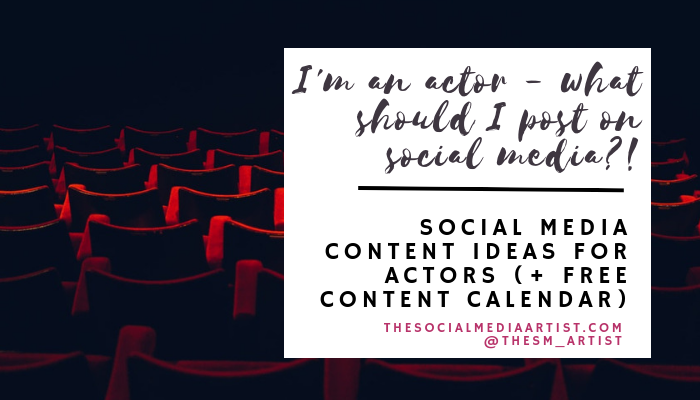
Acting, Facebook, Instagram, Social Media |
There’s no doubt that mastering social media as an actor can be difficult. You want to post content that is interesting, useful and helps build you a loyal audience but there are so many different social media platforms that it can sometimes get overwhelming trying to keep on top of them all. So how do you figure out what to post? And how can what you post help to further and promote your career as an actor?
We’re going to break it down into an easy step-by-step guide so you can worry less about what you’re posting and focus more on what you love – acting!
Step 1 – Choose a content category
When trying to create a cohesive and interesting social media presence as an actor, it can be hard to know exactly what to post. In our experience, the type of content that is perfect for you to post can be broken down into 5 categories, regardless of where you’re posting it.
1 – Projects I’m working on
Any media that shows you rehearsing, auditioning, working or in the middle of a project. These kinds of posts help promote you as an actor – they show people that you’re busy, you’re working, and what’s more, you’re in demand! Being busy with work proves the quality of your acting, and will also prove your passion for your craft.
2 – Projects / people I love
It’s important to talk about yourself and what you’re doing, but it’s just as important to build a backstory and add some personality to your profile. Whether you are looking to use social media to increase your profile, help you network, or help you get jobs (or a combination of all of these), social networks are designed for sharing not only what you’re doing, but who you are. Sharing what inspires you, or what continues to motivate you helps your audience to understand you better.
3 – About me (as an actor)
There’s thousands, even millions, of actors in this world, with many of them vying for the same roles and same opportunities. When it comes to *really* standing out, you have to show what makes you unique – what you can bring to a role that nobody else can. Maybe you have a unique story to tell, maybe you are inspired by someone really eccentric, or maybe you have a real-life experience that makes you the person who can really stand out in a particular role… whatever it is that makes you YOU is worth highlighting!
4 – About me (as a person)
Just like showing off who you are as an actor, you also need to show who you are behind your job too!
Personality is what sets you apart from the rest. What you have to offer is special and unique – there is no other you in this world! So why not highlight what makes you uniquely you, and use it to your advantage? At the same time, personality is what draws people to you, creating relationships, friendships and professional contacts. Don’t be afraid to show who you are!
5 – Fun posts!
You want to show you’re serious, motivated, professional and passionate… but balance is the key to life and sometimes you have to cut loose!
Showing how you like to have fun, telling jokes, sharing memes (especially those related to your art), and general silliness is advised! The acting world is full of fun characters and eccentric personalities so don’t be afraid to show yours – you’re in the business of entertainment, after all! 😜
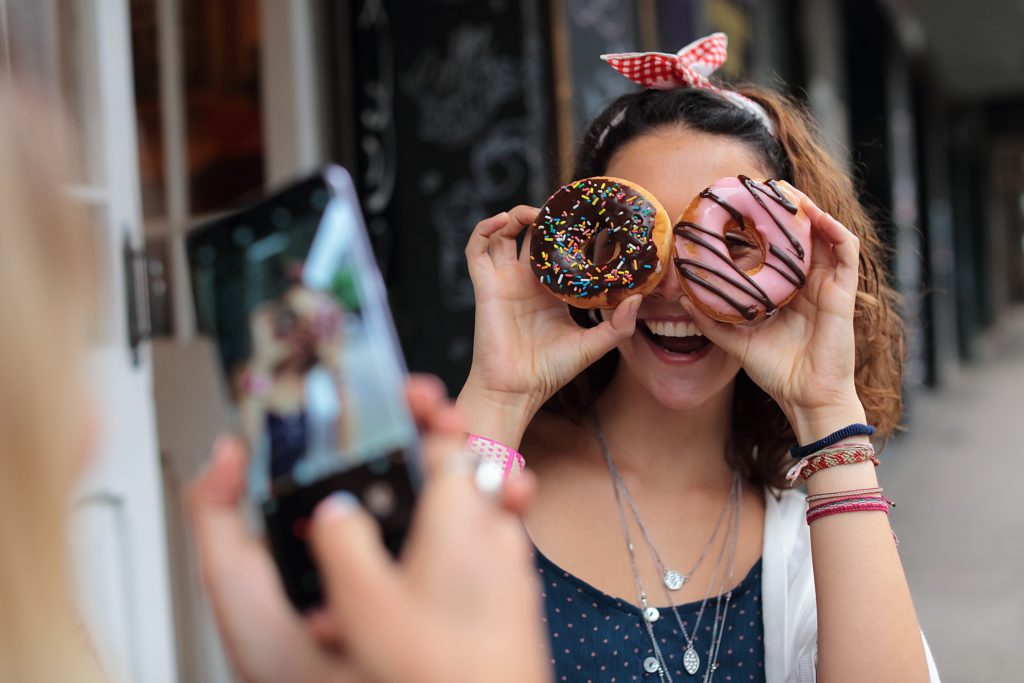
Step 2 – Choose your media
1 – Photo
Photos can be the easiest type of content to post – it’s quick, it’s easy, and you can get pretty amazing quality even on a smartphone.
Great for: selfies, action shots, behind-the-scenes, headshots, silly posts, etc.
2 – Video/ Gifs
More and more people these days like watching videos, with an amazing one-third of all online activity consisting of watching video! Whether it’s a short video, a Boomerang or a gif, your audience will always enjoy you posting some video content!
Great for: showing auditions, acting, monologues, previews of shows or film, behind-the-scenes, showing your personality, etc.
3 – Link (to websites, blog posts etc)
If you have a blog or a website, or if you find something that’s so interesting that you feel you want to share it – go ahead! Links are especially good on Facebook, where people can easily click through to the website.
Great for: sharing your thoughts, sharing news about your industry, sharing links to other social media or your website, linking to projects you’re working on or involved in, promoting tickets to shows, etc.
Step 3 – Choose your hashtags
Hashtags are important when it comes to social media (especially Instagram and Twitter); in fact, posts with at least one hashtag have 12.6% more engagement than those without. Imagine how much more engagement you could get with more hashtags, all targeted specifically to your audience? The answer is – a lot more! And this could be the key to building an audience that really enjoys following you on social media!
Need help making your Instagram captions POP? CLICK to read how to write engaging Instagram captions
You can use online websites to help you find the most popular hashtags (particularly suited for your audience) at places like All-Hashtag.com and Hashtagify.me, but you can also find which hashtags are popular in your niche by analysing what other people in your niche are using. Be careful not to use too many or you can seem spammy and desperate for likes, which will turn people off. Sometimes less is more, but ultimately it’s up to you to decide which ones are effective and suit you.

Step 4 – Publish your post & respond to your audience!
You’ve followed the steps in this post and you’ve posted some GREAT content…. but your work’s not over!
Make sure you respond to all your comments and acknowledge everyone who engages with your content. It’s the sure way to build a relationship with your audience and get people coming back for more!
Still need content ideas? Download the free 31 Days of Instagram Content (For Actors) Calendar!

Facebook, Social Media
The Facebook algorithm changes many times a year, forcing marketers like us to adapt quickly. In the last weeks before 2018, Mark Zuckerberg announced a change to the ad algorithm, that I believe will seriously impact brands and individuals. This post is inspired by the Social Media Marketing Talk Show, where its founder, Michael Stelzner reviews these algorithm changes. I highly recommend listening to it, here (46 min).
This algorithm change will affect almost every business page, brand and personal page. Rather than placing sponsored and sales-driven posts in users’ news feeds, Facebook will prioritize content from friends and family. In the past, the algorithm’s goal was to “show users relevant content”, which helped targeted, sponsored content get seen. Now, there is a shift towards “showing content that sparks conversations and meaningful interaction between people”. This is a radical change, favouring longer comments on posts, over clicks and likes. The idea is to convert users from passively viewing content, to actively engaging with it.
Don’t believe me? See it from Mark himself here.
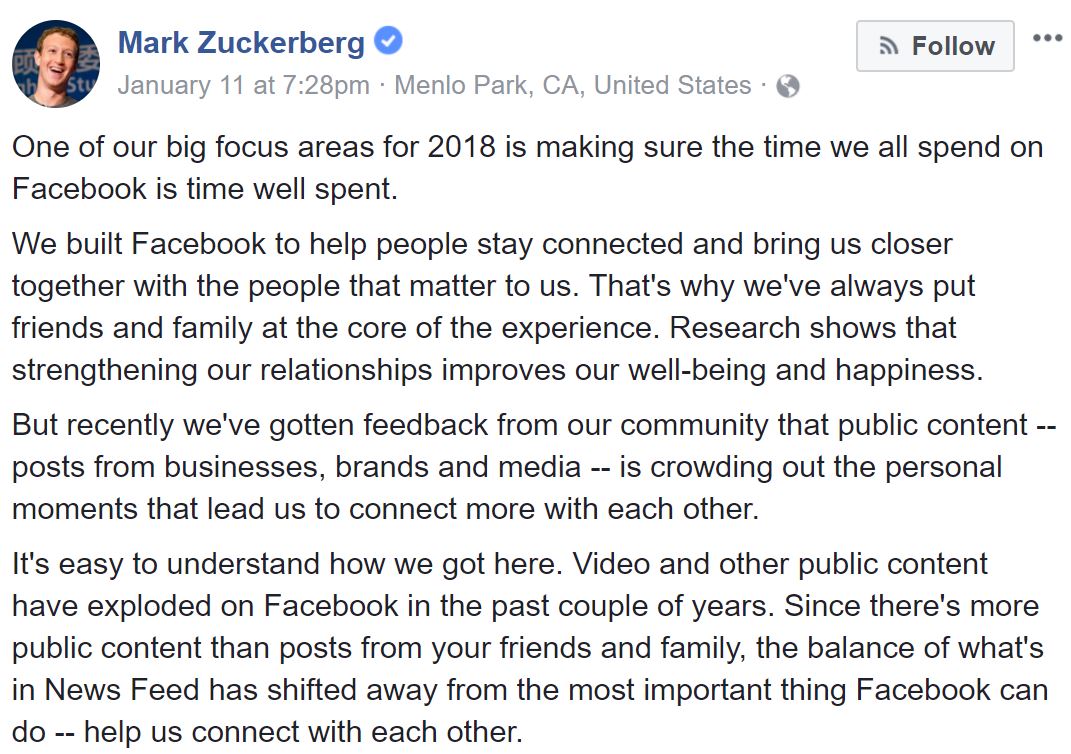
Why is this happening? For the most part, I believe Facebook is using this strategy to reduce fake news and mismatched content. With this change, Facebook will increase their advertising prices, making it harder for illegitimate publishers to reach their viewers – unless they pay for it. I expect many of these publishers will drop off and use other less restrictive social media platforms to do this.
When Facebook first started in 2004, it was designed to be a platform to connect with friends and have unexpected conversations (this is prior to the days of Messenger). Over the past few years, you might have noticed a growing sour attitude towards social media; to Facebook in particular. I’ve been following this shift, noting that many users are annoyed with the trend towards clickbait and superficial attention grabs. Multiple studies show that social media can have a negative impact on our wellbeing, encouraging people to isolate themselves as they passively binge content, distancing them from actual heartfelt conversations. Many feel that the platform has become ingenuine, and is used increasingly as a way for brands to sell to them. The meaningful social connection that Facebook was famous for, has slowly disappeared.
How do we as creative marketers combat this big shift? How do we fight this cynicism and still get our brands seen by the right people? Here are some predictions and optimization techniques I hope you find helpful:
Comment Strategy
Facebook is favouring longer comments (a sentence or more) and shares to likes and clicks. As marketers we need to be creative, encouraging engaged discussions between users. Posts that encourage generic ’me-too’ comments, like “awesome” or “cool post”, don’t inspire conversation or tell stories, and won’t be prioritized in the news feed. The algorithm will also flag copy that specifically encourages users to comment and like their posts, otherwise known as ‘comment-bait’. No more ‘Tag a friend if you agree’ or ‘Comment below…’ in the copy anymore.
Shift your social media goals from driving traffic to community building. Focus on content that encourages storytelling. Once you build your community, only then should you go back to your sales-driven goals.
To create more visibility on your posts:
Visibility Tip #1: Get your employees to start commenting on your posts. Ask them to ask questions and create longer posts that drive conversation among each other.
Visibility Tip #2: Create a list of followers or other brands that could add value to the conversation. If there is a post that would make sense for them to see, tag them. Consider tagging them within the comment section, rather than the post itself. You want to use this tactic sparingly and tag 1-3 people at a time. No one likes to be spammed.
[Tweet “Get your employees to start commenting on your posts. Ask them to ask questions and create longer posts that drive conversation among each other.”]
Facebook Groups
To encourage a stronger community, create a Facebook group, rather than a Facebook Page to gather a group of like-minded followers. Learn how to speak directly to those followers and encourage them to engage with each other. The idea is to create value for your members by connecting them to each other. You never know whom you can connect together and what impact that has on them!
Community Optimization Tip #1: Create events within these groups. Followers will be notified once they are invited to an event. Whether it’s online or an in-person meetup, make sure to create value for your members.
Community Optimization Tip #2: Introduce members to each other by tagging them in the comment section of your post. Or you can create a specific post introducing them to each other. Perhaps these members have a complementary skill and can benefit from meeting each other online.
[Tweet “introduce members to each other by tagging them in the comment section of your post.”]
Community Optimization Tip #3: If you have a collection of posts from your community, try to get a sense of what they talk about and how to speak similarly. If you need help doing this, you can run conversations through a readability or text analysis tool (e.g. MS Word, Grammarly) and then test your copy to match. You can even run your writing through specialized tools and services like IBM Bluemix and Crystal Knows to help match tone. (Bluemix rated this post as analytical, and unsurprisingly, a mix of joyful and sad)
Facebook Live
Facebook Live gets 8x more exposure than organic posts. Although Mark Zuckerberg announced a decline in passive video content, Facebook Live will not get the boot because it is interactive. This may change in the future, depending on the long-term appeal, and whether the trend continues to decline.
Video Optimization Tip #1: Create different lengths of Facebook Live videos. Perhaps you have a quick 1-minute tip of the week you would like to share. Mix this in with longer pieces like interviews, product reviews, Q&As, tutorials, etc.
Video Optimization Tip #2: Promote your Facebook Live videos with a mini Facebook Live preview piece. In the past, I used to promote Facebook Live with images leading up to the event. However, to accommodate the new algorithm change, it’s worth promoting your longer form pieces with a promo video. For example, if you do a weekly interview with an industry pro, you can let members know the event time and details, introduce the interviewee and collect questions to tailor the interview in your shorter content piece.
Video Optimization Tip #3: Caption, caption, caption. If you live in Ontario, the Accessibility for Ontarians with Disabilities Act (AODA) requires an accessible web experience by 2025. All companies will be mandated to share information in an accessible way. For video, this means captioning the video after the Facebook Live is recorded. Luckily, Facebook has an easy tool that does most of the work for you when you edit the video. Look for “Captions” under edit video and “Generate Captions” to automatically create captions for you. You may have to quickly review the generated captions to catch the occasional typo.
[Tweet “Promote your Facebook Live videos with a mini Facebook Live preview piece”]
Paid Ads
It’s no surprise that reach has been decreasing for advertisers year after year. Now, brands are forced to master Facebook ads to increase reach and accomplish their sales goals. Expect ad prices to increase to accommodate competing advertisers who rely on Facebook ads to accomplish their sales goals.
Reach Optimization Tip #1: Create a campaign with the ad objective ‘drive engagement’ to serve your ads to users who typically comment on posts.
Reach Optimization Tip #2: Boost your Facebook Live videos to improve reach on an already algorithm-friendly content type.
[Tweet “Boost your Facebook Live videos to improve reach on an already algorithm-friendly content type.”]
See Content First
The only way to ensure your followers are seeing your content organically is to encourage them to change their notification option for your brand, to ‘see first’. This ensures your followers will get notified every time you post something new, in real time. Note that this option is limited to 30 pages per user, so your followers must REALLY like your page to do this for you. Time this request for key touchpoints, such as after a positive direct message, in a successful video post, or when you have a spike in engagement in your community.
Are we all doomed? Not necessarily. Pages that have high engagement already, will not be impacted. Those who get a few likes once in a blue moon and have no advertising strategy… Yep, those are the ones that will get affected.
There’s no going back to a ‘free’ world on Facebook. If you want your content out there, you must pay for it. If that’s not your style, it may be time to try out a new platform, HELLO INSTAGRAM 🙂
What do you think of the new change? Have you noticed any differences? If you’ve given up trying to keep up with your own social media, leave it to a pro like me. More about me and how I can help, here.
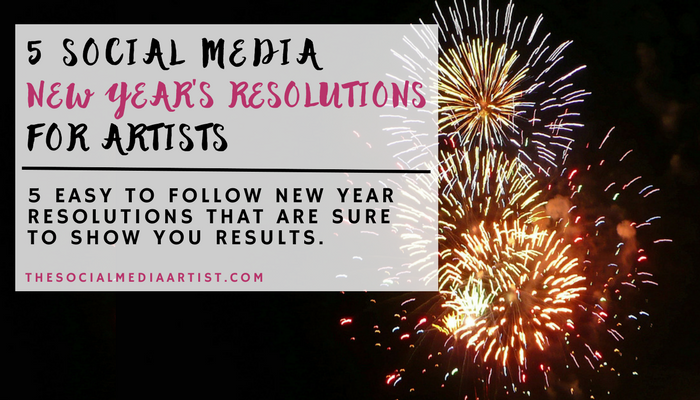
Artist Marketing, Branding, Entrepreneurship, Facebook, Instagram, Social Media, Twitter, Youtube
With every new year comes a whole lot of new year’s resolutions; these can often be hard to stick to, and sometimes are even difficult to come up with in the first place. So for all of you artists out there, we’ve put together a list of 5 relatively simple to follow social media new year’s resolutions that will be sure to keep you stress free, all while helping you earn new fans and followers!
Spend 30 Minutes Per Day on Social Media
Seems simple enough, right? Spending a minimum of 30 minutes a day on social media can help you see a dramatic change in your online presence. Use this time to check your major social platforms, talk to current followers, reach out to potential fans/collaborators, and post new content. Dedicating this small amount of time every day may not seem like much, but it can really make the difference in the long run.
Engage More With Your Followers
Why do you think it’s called social media? If you’re only using your social channels to post content, you’re only fighting half the battle. Engaging and conversing with followers and fans on social media is an absolutely crucial way to build your fanbase. Respond to comments on your posts, thank followers for sharing your content, and use hashtag searches to find relevant posts and accounts where you can create your own conversations.
[Tweet “Why do you think it’s called social media? If you’re only using your social channels to post content, you’re only fighting half the battle.”]
Find Your Best Social Platform, and OWN It
Although being present on multiple social platforms and having a huge following on various channels would obviously be ideal, it isn’t a necessity – especially if you’re just starting out. Do some research to find out who your core demographic is, and what social platform they typically use the most. Also think about which platform would be best to promote your specific type of work and reach potential followers. For a rundown on different popular social platforms and what each is best for, take a look at our post here.
Learn a new Social Platform
This one may seem a little overwhelming, but partnered with our first resolution idea, it’s quite easily achievable. Many platforms make things simple with user-friendly interfaces and designs, and there are more than enough tutorials and articles on the internet that are available to help with almost any problem you may face. Just be sure to learn a platform that is going to work with your goals as well as the artwork you’re creating. Not sure where to start? Here are a few suggestions for up and coming social networks that speak to artists. If you’re a musician, have some fun with Musical.ly , the social network dedicated to music lovers. If you’re an actor, YouTuber or any kind of content creator who loves live video, check out Hype, which is a combination of Vine meets Snapchat meets Facebook Live! If you’re looking for a professional platform to showcase your creative work (think LinkedIn for artists) Behance, is a great tool to display your portfolio while connecting with other artists.
Put Some Money Into Paid Social Ads
Paid advertisements on social channels are an amazing way to boost your follower growth, as well as put your work in front of eyes that may have never seen it otherwise. And the best part about paid ads, is that you get to choose exactly how much money you want to spend, and exactly when you want to stop. With only a few dollars a day, you can put out content that can help you see a significant change in the way you use social media.
Hopefully this list puts your mind at ease a little bit when it comes to thinking of that New Year’s resolution; just stay focused and stay determined and you’ll be sure to see results. But most importantly, Happy New Year!
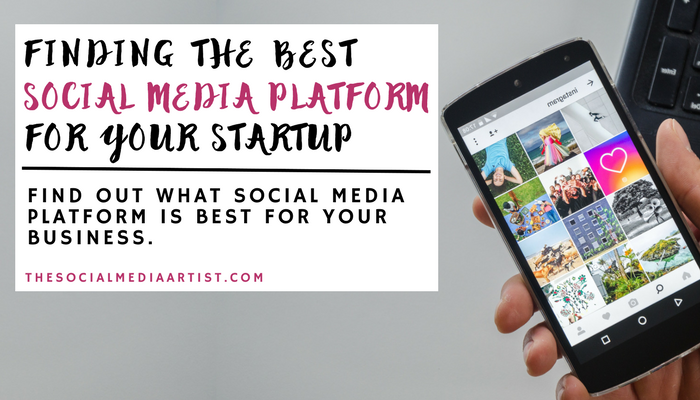
Facebook, Instagram, Snapchat, Social Media, Twitter, Youtube
One of the most important things when it comes to social media marketing is knowing where your target audience lives online. Every social media platform has its own benefits as well as specific purposes that make it unique. While being able to effectively use more than one is ideal, it isn’t realistic for a startup. Do you have the time or resources to focus on more than one platform? If not, taking the time to properly focus on one is better than having a poor presence on many.
We took a look at five of the biggest social platforms and gathered data on average user age, gender, and more to make finding your best social media platform a walk in the park.
Key stats:
- 1.9 billion unique monthly users
- 83% of online women, 75% of online men
- Primarily ages 18-49
Facebook is an excellent social media platform for building a community and engaging with followers. Being able to like and reply to followers’ comments and posts promotes healthy customer relationships and feedback. It is also a great platform for posting multiple kinds of content all in one place. If you plan on sharing a mixture of content including photos, videos, updates and general news, then Facebook is the place to be.
Pros
- Central hub for a variety of content
- Different forms of engagement (likes, loves, wows, comments, shares etc.)
- Biggest social platform
Cons
- Over saturated with other business pages
- Millennials are more present on other social networks
- Low organic reach means heavy reliance on boosted posts and ads
Key stats:
- 1 billion unique monthly users
- 55% male, 45% female
- Primarily ages 18-49
YouTube reaches more 18-49 year olds than any cable network, and it is an absolutely critical place to be if your brand’s primary focus is video content. User comments allow for followers to leave feedback, general brand and content opinions, as well as ideas for new video content they’d like to see. Another great thing about YouTube is that it is owned by Google, meaning it is given priority over other platforms in Google search results! So if you think that your brand would benefit mainly from video content such as how to videos, vlogs, or video reviews, then get on YouTube immediately.
Pros
- Biggest video platform
- Improves search results (owned by Google)
- Great way to build a community
Cons
- Strictly for video content and video content only
- High quality video content can be time consuming
- High volume of negative comments and ‘trolls’
Key stats:
- 600 million unique monthly users
- 38% of online women, 26% of online men
- 90% of users are under 35
Instagram is one of the fastest growing social platforms out there, with a primary focus on visual content. 53% of Instagram users follow brands, making it a great place for businesses to be. It is also a great platform for running photo contests and prize giveaways, using branded hashtags to get followers participating. If your startup revolves around products or services that would best be represented visually (retail, food etc.) then being on Instagram is a no brainer. But be careful! Visual content should be visually appealing, so having high quality photos and videos with proper composition, lighting and direction is key to keep up with competition.
[Tweet “53% of Instagram users follow brands, making it a great place for businesses to be.”]
Pros
- Fast growth
- Majority of users follow brands
- Huge millennial user base
Cons
- Not a big platform for users over 35
- Not the best platform for communicating with customers
- High quality photo and video content can be time consuming
Key stats:
- 317 million unique monthly users
- 22% of online men, 15% of online women
- Primarily ages 18-29
Given that Twitter is primarily a copy based social platform, it is fantastic for creating a dialogue with your customers. Regular news updates along with general questions and concerns can be main focal points for creating personable conversations with your customers. Not to mention, hashtags are huge on Twitter; they can be strategically utilized to improve brand awareness and allow customers to easily find you through relative searches. If your main focus as a brand is offering exemplary customer service, building relationships and creating engaging dialogue directly with your customers, then Twitter is the platform for you.
Pros
- One of the best platforms for building customer relationships
- Hashtags make it easier to be discovered
- Not a lot of resources required
Cons
- Low character limit when posting
- Can be confusing to new users
- User growth is stalling
Key stats:
- 300 million unique monthly users
- 70% female, 30% male
- Primarily ages 18-24
Snapchat is another one of the fastest growing social networks, and is also one of the most personable. With the ability to create real-time marketing efforts that cater specifically to your audience, Snapchat can give your followers a behind the scenes look into your brand. Geofilters can also be used to spruce up live events, getting fans and followers more engaged through the sharing of snaps with your custom branded filters. If events, constant sharable moments and regular follower engagement are a big part of your brand, then Snapchat is a great platform to get started on.
Pros
- Extremely fast growing
- Huge platform for millennials
- Great for creating personable posts
Cons
- Brand becomes more transparent
- Tracking success is more difficult than on other platforms
- No ability to like, comment, etc.
Hopefully this article helps you get off on the right foot when it comes to selecting the best social media platform for your startup. Regardless of whatever platform(s) you choose, just remember that nobody likes to be constantly delivered a sales pitch. Keep the majority of your posts personable and natural in order to promote engagement and attract new followers. This is social media, so let’s keep it fun!
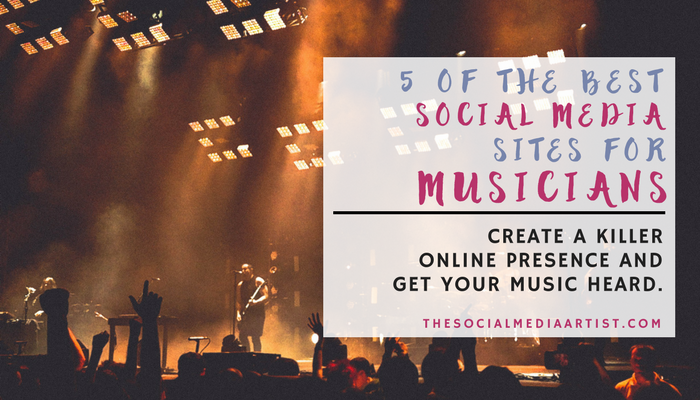
Artist Marketing, Branding, Facebook, Instagram, Music Marketing, Social Media, Twitter
As all things slowly start to hop aboard the digital train, music promotion has already boarded and is finding its seat. Music streaming and digital sales are edging out physical merchandising and advertising more and more each day, and having an online presence for your music is now a must-have. But it doesn’t have to be so hard! We’ve put together a list of what we believe to be 5 of The Best Social Media Sites for Musicians to get you started. Let’s dive in.
Soundcloud is an enormous community of artists and one of the best platforms to share tracks, receive feedback, build a fan base, and find other musicians. Many artists such as Post Malone and Bryson Tiller actually started their careers off the backbone of Soundcloud and were discovered straight from the site itself. With the music scene shifting more towards streaming rather than direct physical sales, this is a great platform to be taking advantage of.
Some of the great features of Soundcloud are:
- Users can like and repost your tracks. Similar to Twitter, when someone reposts your track, it will show up on their personal stream and allow their followers to see it, ultimately putting your music in front of more sets of eyes – Score!
- Comments on tracks are time stamped at the specific time in the song in which they were posted, giving you a neat way of seeing what specific part of your track made people want to comment.

Real-time comments are one of the many great features offered by Soundcloud.
- Statistics on when your tracks are getting plays, reposts, likes and comments are free with any basic account. Paid accounts can offer more valuable statistics such as plays by country & city, the names of the users who are playing your music the most, and which social networks and websites people are coming from to get to your songs.
Just like Soundcloud, Bandcamp is another one of the best social media sites for musicians, labels and fans to get together and share music. While Soundcloud is more social media based with commenting and reposting, Bandcamp is skewed towards creating a more well-rounded sales platform for your music and brand, and is home to more full length albums, merch sales, and more.
Some interesting features offered by Bandcamp include:
- Setting a price or a “pay what you think is fair” option for your music so that you can start making money off of your track instantly. You can even create your own discount and promo codes!
- New artist recommendations that can automatically put your music in front of new fans, ultimately growing your potential follower base without having to lift a finger.
- In depth statistics showing what’s being purchased and when, where fans are coming from and more. A paid account can even link your Bandcamp statistics with Google Analytics for some serious data collection.
- The ability to sell merchandise! You can bundle together your music and merch to make different packages available at different price points.
Although not directly related to music promotion, Facebook is an excellent platform to build a central hub for fans to reach out and have discussions, learn about upcoming shows, singles and more. With over 2 BILLION active users every month, it is also a great place to share content that has the potential to go viral.
Facebook offers many great page management tools that make it easy for you to highlight important info and find new fans;
- The use of a strong header image that shows upcoming singles, gig dates etc. is a great way to advertise important events without actually showing people an advertisement.
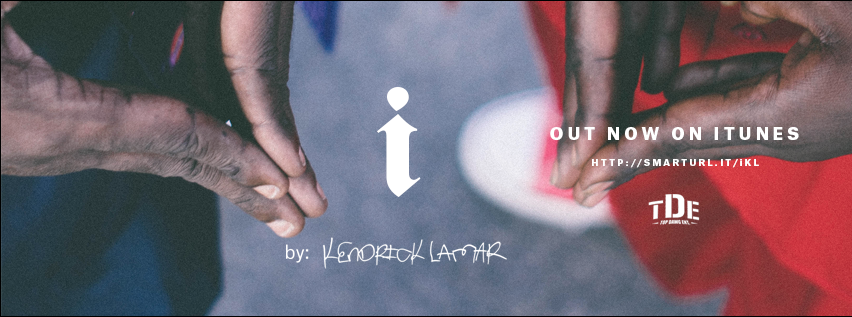
Here’s an example of a good promotional header image.
- The ability to pin posts allows you to pin popular content that is performing well to the top of your page where it can stay until you decide otherwise (perhaps a new video or single?)
- Pro Tip: Previous posts that have performed well can be used to grow your fan base by simply clicking on the ‘likes’ button to see who has liked the post, then clicking the ‘invite’ button to invite those likers directly to become fans of your page.
When it comes to directly communicating with fans, fellow musicians, and even labels, Twitter is absolutely one of the best social media sites for musicians to be on. Creating a dialogue and engaging with those that are most important to you is an amazing way to build your fan base, get in touch with other artists for potential collaborations, and even get discovered by labels (fingers crossed!)
In order to get on top of the Twitter game, knowing how to get the most out of the platform as well as it’s features is crucial;
- Start utilizing Twitter Lists. This feature allows you to categorize people/accounts into specific groups of your choosing. Make a group for labels of interest, number one fans, music blogs, favourite artists etc. so that certain people of interest can be found in one place with ease.
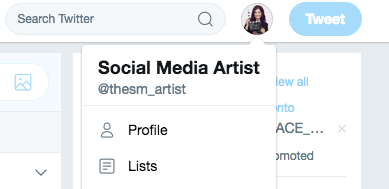
Twitter Lists is located in the drop down menu when clicking on your profile icon.
- Pay attention to trending hashtags! Stay current and be aware if any of the content you are uploading will naturally relate to trending topics.
- Reach out to other artists to build relationships, music blogs for possible features, and stay up to date on what your competition is doing.
- Insert links at the beginning of your tweets rather than the end; they are more likely to get clicked on that way. Also be sure to use calls to action! If you ask for a retweet, there’s a better chance you’ll get it.
[Tweet “Reach out to other artists to build relationships, music blogs for possible features, and stay up to date on what your competition is doing.”]
Instagram is one of the most popular and active platforms today, so not taking advantage of it would be a huge missed opportunity. Being the major platform for photo and video content, creating a brand for music on this platform and showing off behind the scenes footage of new song development, musician life, live performances and more is a great way to get your music heard.
Some important tips for using Instagram are to:
- Use relevant hashtags. Up to 30 hashtags can be included in a post and can easily be hidden in the first comment of your post instead of the caption to avoid the look of being too ‘hashtag-crazy’.
- Use the ‘story’ feature located at the top of the app to post a photo or video that lasts 24 hours and shows people what you’re up to in the moment. You can also start live videos from here!
- Follow other artists, labels, and music blogs. By now I’m sure you’re seeing a pattern. Building relationships is CRUCIAL on every platform and is one of the most important aspects of ALL kinds of marketing!
[Tweet “Building relationships is CRUCIAL on every platform and is one of the most important aspects of ALL kinds of marketing!”]
The world of digital music promotion can sometimes be a little overwhelming, especially when it seems like there is an endless number of websites and apps claiming to be the “be all and end all” for selling your work. But realistically, there is no one platform that is best to use, and instead you’ll find that creating a consistent presence across multiple platforms is the best method for successful music marketing. Hopefully this list gets you started off in the right direction, but if you have any questions, don’t hesitate to send us an email :).


